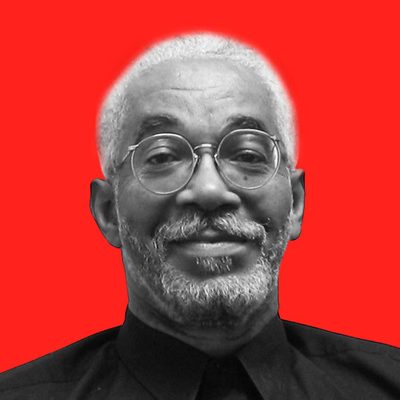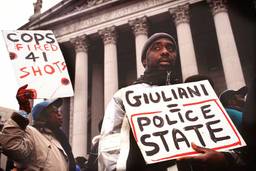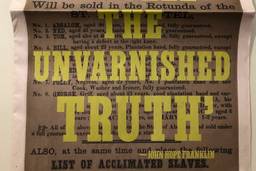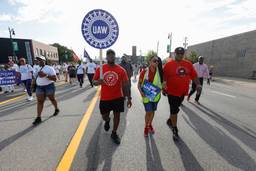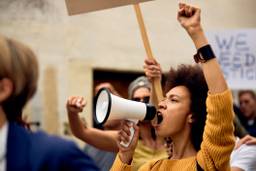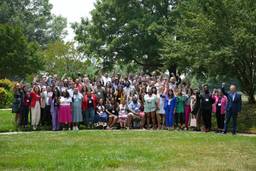Hurricane Katrina made clear that poverty and blackness remain too intertwined to be coincidental. But while too many black people remain poor, a growing number do not.
Since 1968, the year of Dr. Martin Luther King, Jr.’s death, the black middle class has tripled, as measured by the percentage of families earning $50,000 or more. But the percentage of black children living at or below the poverty line also has increased since King’s assassination. What’s more, the incarceration epidemic (and its attendant woes) has increased poverty among countless young black men just at the peak of their earning potential.
The simultaneous growth of these disparate groups within the black community has helped nurture a class divide that is growing more rancorous. Signs of this conflict have been bubbling just beneath the public surface for quite a while.
One example of this growing tension has been the ongoing angry demonstrations by a group of young ex-offenders outside of the Rev. Jesse Jackson’s Rainbow/Push Chicago headquarters. The group opposes Jackson’s brokerage-style of leadership and seeks to curtail his role as the black community’s leading voice. To some extent these tensions are both class and generational: Jackson’s civil rights paradigm may resonate with beneficiaries of affirmative action, but it rings few bells with ex-inmates from the hip-hop generation.
So far, this gathering storm has escaped public notice. But there are increasing signs that we’re in for a change.
We got a strong signal in May 2004, when Bill Cosby castigated “lower-economic people” in a sweeping jeremiad. At an NAACP confab commemorating the 50th Anniversary of the Brown v. Board of Education desegregation decision, Cosby said “people marched and were hit in the face with rocks to get an education, and now we’ve got these knuckleheads walking around … the lower economic people are not holding up their end of the deal.
“These people are not parenting,” he said. “They are buying things for kids – $500 sneakers for what? And won’t spend $200 for ‘Hooked on Phonics.’
“I can’t even talk the way these people talk: ‘Why you ain’t,’ ‘Where you is’… You can’t be a doctor with that kind of crap coming out of your mouth.”
He mocked the way some African-Americans name their children: “with names like Shaniqua, Taliqua and Mohammed and all that crap, and all of them are in jail. … They are standing on the corner and they can’t speak English.”
His speech, which seemed to be extemporaneous, was a wide-ranging rant peppered with familiar fulminations. Many African-American commentators let the speech pass without initial comment. After all, Cosby is a popular entertainer with a history of philanthropy for black causes. Even the Rev. Jesse Jackson, who sat next to Cosby during his controversial NAACP speech and who usually takes great umbrage at any racial insult, let the beloved comedian slide.
But Michael Eric Dyson, a prolific author who writes often on African-American culture, adroitly utilized Cosby’s remarks as an occasion to examine the contours of the growing class divide in black America. In his unambiguously titled book, Is Bill Cosby Right?: Or Has the Black Middle Class Lost Its Mind?, Dyson eviscerates Cosby and the “Afristocracy” (the black elite and professional classes) that he says looks with increasing disdain on the black poor.
Dyson persuasively argues that an inequitable system relentlessly victimizes the “lower economic people” Cosby condemned. In contrast to the “Afristocracy,” he has dubbed them the “Ghettocracy” (the black “underclass”, the working class/working poor and the incarcerated).
Their behavior patterns are adaptations to the limited options they face in a white supremacist culture, Dyson contends. The popular University of Pennsylvania professor, who also is an ordained Baptist minister, further charges that too many members of the black middle class have abandoned the goals of the civil rights movement that made their existence possible. He cites evidence that well-to-do African-Americans increasingly blame poor blacks for their own plight.
Dyson’s themes echo back to E. Franklin Frazier’s classic 1957 text, The Black Bourgeoisie, which scornfully chronicled moneyed African-Americans who mimicked whites while demeaning their less fortunate brethren. But Dyson’s attempt to frame the poor’s dysfunctional behavior in a historical context makes him vulnerable to the charge that he is romanticizing pathology.
Many cultural critics hurl that same charge at hip-hop artists. Part of Cosby’s critique, which he took on the road following the extraordinary response to his 2004 speech, is an attack on the hip-hop aesthetic of “representing”– that is, celebration of your situation.
The class divide within the black community is at a point I would characterize as a low intensity conflict. I fear the intensity will increase as record numbers of ex-inmates continue to flood neighborhoods that are woefully ill-equipped to rehabilitate and assimilate them.
Recent natural disasters have provided a glimpse of the domestic disasters that await us all if we continue to ignore the widening gap between rich and poor.

I hope you found this article important. Before you leave, I want to ask you to consider supporting our work with a donation. In These Times needs readers like you to help sustain our mission. We don’t depend on—or want—corporate advertising or deep-pocketed billionaires to fund our journalism. We’re supported by you, the reader, so we can focus on covering the issues that matter most to the progressive movement without fear or compromise.
Our work isn’t hidden behind a paywall because of people like you who support our journalism. We want to keep it that way. If you value the work we do and the movements we cover, please consider donating to In These Times.
Salim Muwakkil is a senior editor of In These Times and host of “The Salim Muwakkil Show” on radio station WVON-AM in Chicago. Muwakkil was also contributing columnist for both the Chicago Sun-Times (1993 – 1997) and the Chicago Tribune (1998 – 2005). He is also a co-founder of Pacifica News’ network daily “Democracy Now” program and served as an adjunct professor at Northwestern University, University of Illinois, the Art Institute of Chicago and Chicago’s Columbia College.
